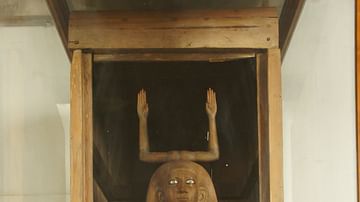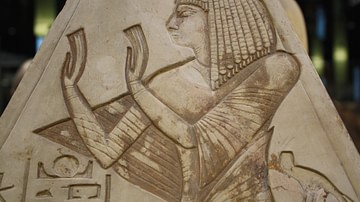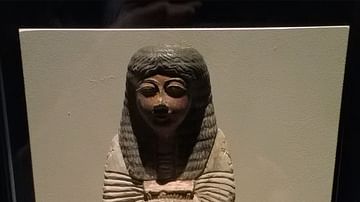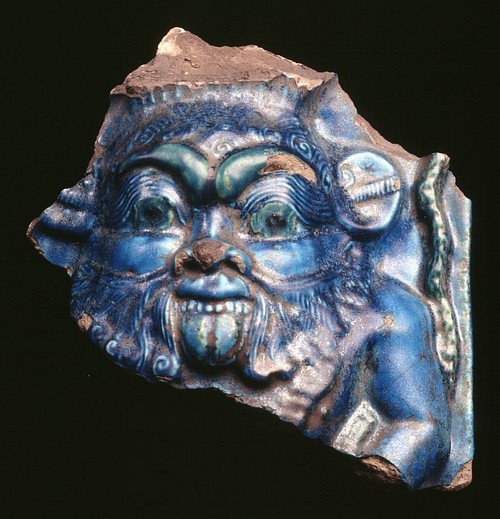
Bes is the ancient Egyptian god of childbirth, fertility, sexuality, humor, and war, but served primarily as a protector god of pregnant women and children. He is regularly depicted as a dwarf with large ears, long-haired and bearded, with prominent genitals, and bow-legged.
Usually he is shown holding a rattle but sometimes a snake (or snakes), a knife, or sword. The image of Bes was often positioned at gates for protection and almost always appears outside of birth houses. He was also a popular image used in household goods such as mirrors, cosmetic cases, on furniture, and as knife handles.
His feminine aspect is Beset who appears in spells to ward off ghosts, dark magic, evil spirits, and demons. Bes himself is actually a demon, more than a god, but that word should not be understood in the modern sense. A 'demon' (from the Greek word daimon) could be a good or bad entity along the lines of the Mesopotamian demon Pazuzu, who likewise presided over pregnant women and infants. Although Bes is frequently associated with his feminine aspect as consort, he is more regularly identified with the goddess Taweret (Tauret), the hippopotamus deity of childbirth and fertility.
Origin & Nature
Even though Bes was among the most popular gods of ancient Egypt, no story of his origin has been found. He shares similarities with at least nine other deities, according to Egyptologist Richard Wilkinson, who lists Aha, Amam, Hayet, Ihty, Mefdjet, Menew, Segeb, Sopdu, and Tetetenu along with Bes in near uniformity of role and likeness (102). What set Bes apart from these others, apparently, was his unique character.
He was not a god in the same sense that Osiris or Thoth were, had no temple (except one protecting the grapes of the vineyard at the Baharia Oasis), and no formal worship, but was honored in the homes of the Egyptians from the time of the Old Kingdom (c. 2613 - c. 2181 BCE) through the Ptolemaic Dynasty (323-30 BCE) and on into the Roman Empire, although his popularity is most widespread from the New Kingdom of Egypt (1570-1069 BCE) onwards. His role as protector of children expanded to protector of anyone who placed themselves under his care and Egyptian (and later Roman) soldiers had images of Bes inscribed on their shields and would drink from Bes-engraved goblets prior to battle.
The protective nature of Bes was expressed through his skill as a warrior who fended off evil but was also seen in his lighter side. In keeping with the Egyptian concept of the value of balance, Bes is as often seen in art laughing, dancing, and singing as he shown as a fierce warrior/protector. He was thought to entertain little children with his songs, and if a child were seen smiling or laughing seemingly at nothing, it was thought Bes was the cause. This may appear strange as Bes was most often depicted as an ugly, frowning dwarf who frequently displays his immense genitals, but as Wilkinson writes:
Despite his appearance, which changed in many details over time, Bes was deemed beneficent to humans and he was accepted by all classes of Egyptians as a powerful apotropaic deity [one who wards off evil and protects against bad luck]...Just as the Bes figure subsumed various minor gods and demons, in later times he was himself syncretized with other protective deities, forming the `core' of a composite deity whose elements included Amun, Min, Horus, Sopdu, Reshef and other gods. Mythologically, Bes could also be associated with Ra, Hathor, and Horus - and a female form of the god, Beset, sometimes appears as the mother of Horus. (102)
Although it has been suggested that Bes was originally a Nubian, Libyan, or Syrian deity, this is mainly speculation and, as Wilkinson and other Egyptologists note (Pinch and David among them), is unnecessary effort. The god first appears in art from the Old Kingdom of Egypt, and there seems no compelling reason to seek an origin for him outside of Egypt.
Worship & Daily Life
As there was no formal temple or clergy for Bes, neither was there formal worship. People paid homage to Bes in the home or at birth houses where he stood guard. Egyptologist Rosalie David writes:
Domestic gods were worshipped at a shrine filled with stelae, offering tables, water jars, braziers, and vases in a separate area of the home. Worship at home probably reflected the rituals performed in the great temples and would have included the presentation of food offerings and libations and the burning of incense in front of the god's statue. (Handbook, 118)
In more modest homes which could not afford stelae, offering tables, and vases, a simple statue of Bes would be placed on an altar and whatever one could afford would be offered. Bes was mainly worshiped through the everyday activities of the people as they went about their business. Bes was often carved onto furniture, for example, and especially beds to protect people (especially children) from evil spirits or ghosts which might come in the night.
Wilkinson notes how "the vast range of objects upon which Bes was depicted and the large number of his images and amulets demonstrate his great popularity as a household deity" (104). He appears on unguent jars, headrests, amulets, bracelets, couches, beds, chairs, mirrors, knives, and many other household items. He has been found in the ruins of the palace of Amenhotep III at Malkata and in the workmen's houses at Deir el-Medina. Rosalie David notes how the two most popular gods worshiped at Deir el-Medina were Bes and Taweret who appear frequently together in art found in the most modest to the grandest homes in that area (Handbook,118).

David points out how Bes was integral in the most basic aspects of life as a god of "love, marriage, dancing, and jollification" who also "assisted at childbirth and protected the young and weak" (Handbook, 118). As part of his duties, he was entrusted with encouraging toilet training in the young and also taught both boys and girls to be brave, to fight for justice, but also to enjoy life and sing and dance.
He further could influence a boy's occupation in that a child (almost always male) who had the same short and chubby body type as Bes was thought to have been chosen by the gods as a Merchant Priest, a member of the clergy who monitored the goods which came into and went out from the temple. Bes was considered a protector of these goods and Merchant Priests were often Bes-like in body type. He also encouraged girls in their domestic duties and, like Bastet, guarded their secrets and protected their health.
Bes & Women's Interests
Bes was originally, and remained chiefly, the god of pregnant women and childbirth. Women who were experiencing difficulty in conceiving would visit a Bes Chamber (also known as an incubation chamber) at a site such as the Temple of Hathor at Dendera where they would spend the night in the god's presence. In the time of the Ptolemaic Dynasty, these Bes Chambers were decorated with images of a naked Bes with an erect phallus and a naked goddess to encourage fertility and healing. Women regularly used or carried objects engraved with the god's likeness and even had images of him tattooed on their bodies. Egyptologist Geraldine Pinch writes:
Egyptian "old wives" probably told stories about the antics of Bes, but they do not survive in the written record. The evidence for dwarf deities is mainly pictorial. They appear on magical objects, bedroom furniture, and items used to contain or apply makeup. Bes amulets and figurines were popular for over 2,000 years. Some women even decorated their bodies with Bes tattoos to improve their sex life or fertility. (118)
From the New Kingdom onwards, Bes became increasingly depicted in the company of the pregnant Taweret in images celebrating birth and fertility. Pinch notes, "Bes and Taweret were also the guardians of the divine infants worshipped in the Birth Houses of temples of the first millennium BCE. Temple and magical texts give Bes or Bes-Shu the role of opening the womb to allow a child to be born" (119). These birth houses were a regular aspect of temples all over Egypt and featured statuary or inscriptions of Bes outside and wall paintings of Bes and Taweret inside. One of the best-known images of Bes, in fact, comes from the birth house at the Temple of Hathor at Dendera. Scenes from these birth houses were often painted on the walls of homes and even appear on the walls of the worker's house at Deir el-Medina to encourage fertility and ensure protection.
Female musicians regularly carried amulets of Bes or had tattoos of the god to inspire their art. Prostitutes also were tattooed with images of Bes as Egyptologist Joyce Tyldesley notes: "Prostitutes used their musical skills to entice their clients and a link between music, feminity, sex, and even childbirth is suggested by the Bes tattoos on musical prostitutes's thighs" (130). Priestesses, dancers, and musicians would also tattoo themselves with images, however, and scholars disagree on whether it was primarily prostitutes who decorated themselves with images of Bes or this was a practice observed by women in the arts and Egyptian religion generally. The dancer Isadora of Artemisia (l. c. 206 CE), for example, was a famous castanet dancer who had a tattoo of Bes on her thigh. Isadora was a free woman and a highly paid artist who commanded a price of thirty-six drachmas a day, travel expenses, insurance for her wardrobe and jewelry, and meal expenses. No records indicate in any way that she was a prostitute.
Bes in his feminine form, as noted, was frequently associated with Hathor and, by this link, to the concept of the Distant Goddess. The Distant Goddess was a deity who left her home to go on an adventure - usually against the wishes of her father - and then returned or was brought back and, by this action, initiated some kind of transformation. Bes is seen in depictions as a monkey, entertaining the goddess upon her return, or as the goddess herself. The transformative aspect of Bes and his fearsome appearance define him as a 'trickster god' - one who may appear harmful but has humanity's best interests at heart.
The Divine Guardian
Bes was frequently called upon in a person's youth for protection, either by a parent, guardian, or by one's self. The Magical Lullaby of ancient Egypt was a spell a mother or older sister would sing to ward evil spirits away from a sleeping child, and Bes was sometimes invoked along with this poem for maximum protection. Mothers would draw an image of Bes on their child's left hand and wrap the hand in cloth blessed by the temple so the child would have pleasant dreams. The image of Bes on the hand associated with the dream world would drive away any spiritual elements which might give the child nightmares.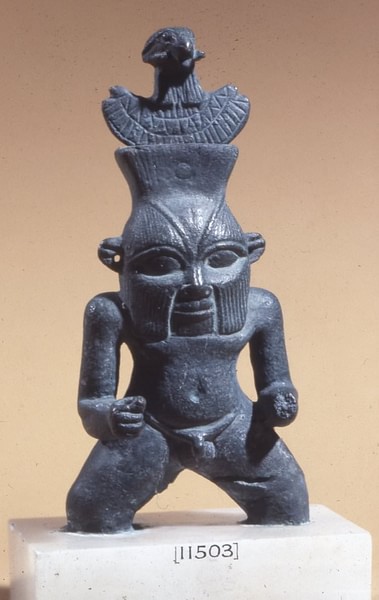
Just as Bes guarded one in one's sleep, he was there throughout one's day encouraging, enlivening, and protecting. Wilkinson notes the work of scholar James Romano who demonstrated that "the origin of the Bes iconography is most likely to be found in the image of a male lion rearing up on its hind paws" (102). The lion was one of the earliest zoological images for the power of the gods and the forces of nature. The suggestion that Bes originated from lion imagery makes sense when one considers how the lion was used in iconography throughout Egyptian history.
The lion always symbolizes divine or temporal power, protection, majesty, and vitality. Bes, the shaggy-maned dwarf, may lack the dignity of a lion in many of his depictions but certainly embodies the elements the Egyptians believed lions symbolized. In sleep or awake, throughout one's life, Bes was always watching out for people, protecting them, and encouraging them to do their best in life.

